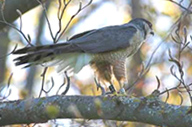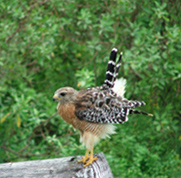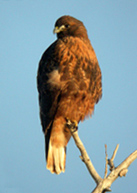Hawks
Hawks
 Conservation Genetics of Threatened Swainson’s Hawks
Conservation Genetics of Threatened Swainson’s Hawks
The Swainson’s Hawk is a state-listed threatened species in California and is believed to be in decline (CDFG 2002; England et al. 1997). Once flying throughout lowland regions of California, now Swainson’s hawks are found only in portions of the Central Valley and Great Basin regions where suitable nesting and foraging habitat still remains. Estimated numbers have dropped from over 17,000 pairs in the early 1900’s to 800 pairs (1994). Combined estimate for 2005-2006 was 2081 breeding pairs according to a CDFG study. We worked with the California Swainson’s Hawk Technical Advisory Committee and California Department of Fish and Game to supply information about genetic diversity, population structure, and taxonomic distinctiveness of Swainson’s Hawks in California (publications below).
Hawk of Galápagos Islands has Swainson’s Hawk as closest relative
In a collaboration between our lab and Dr. Patricia Parker’s research team at the University of Missouri, Josh Hull analyzed Galápagos hawk DNA and discovered strengthened evidence that the closest species relative of the Galápagos hawk is the Swainson’s Hawk. This work is published in Biological Journal of the Linnean Society, the direct descendant of the oldest biological journal in the world, which published the papers by Darwin and Wallace. Follow the links below to learn more.
Publications
- Reduced MHC and neutral variation in the Galapagos hawk, an island endemic. Bollmer JL, Hull JM, Ernest HB, Sarasola JH, Parker PG. BMC Evolutionary Biology 2011, 11:143.
- Hull JM, Savage WK, Bollmer JL, Kimball RT, Parker PG, Whiteman NK, Ernest HB. 2008. On the origin the Galápagos hawk: An examination of phenotypic differentiation and mitochondrial paraphyly.Biological Journal of the Linnean Society. 95:779 – 789.
- Hull J.M., R. Anderson, M. Bradbury, J. Estep, H. B. Ernest. 2008. Population structure and genetic diversity in Swainson’s Hawks (Buteo swainsoni), implications for conservation.Conservation Genetics 9:305-316.
- Hull J.M., W. Savage, J.P. Smith, N. Murphy, L. Cullen, A.D. Hutchins, H.B. Ernest. 2007. Hybridization among Buteos: Swainson’s Hawks (Buteo swainsoni) × Red-tailed Hawks (Buteo jamaicensis). The Wilson Journal of Ornithology,.119(4):579–584.
- Hull J.M., D. Tufts, J.R. Topinka, B.P. May, H.B. Ernest. 2007. Development of 19 microsatellite loci for Swainson’s Hawks (Buteo swainsoni) and other Buteos. Molecular Ecology Notes 7 (2), 346–349.
Read about Swainson’s Hawks at the California Department of Fish and Game web sites:
Swainson’s Hawk Inventory
Threatened and Endangered birds in California including Swainson’s Hawks
 Coopers Hawks: Gender determination by DNA and morphological markers; Exposure to West Nile virus (antibody levels)
Coopers Hawks: Gender determination by DNA and morphological markers; Exposure to West Nile virus (antibody levels)
Gender determination and differential migration in Red-tailed Hawks (Buteo jamaicensis), Red-shouldered Hawks (Buteo lineatus), and Cooper’s Hawks (Accipiter cooperii)
Gender determination in the field can be difficult for many bird species because males and females have identical plumage. However, the two sexes often differ in size. In the three raptor species mentioned above, females are usually (but not always) larger than males. By comparing morphological data (measurements of physical characters) from males to that of females, we were able to determine the best measurements for researchers to use to sex individuals in the field. We used a genetic test to separate males from females in order to compare their measurements. By using a morphological method to sex individuals, we could then determine if the sexes migrate at different times through the Marin Headlands. We collaborated with the Golden Gate Raptor Observatory in the Marin Headlands, Lindsay Wildlife Museum Wildlife Hospital, the UC Davis Veterinary Teaching Hospital avian service, and others for both genetic samples and morphological data.
 Red-shouldered, Red-tailed, and Coopers Hawks
Red-shouldered, Red-tailed, and Coopers Hawks
- Conservation importance of testing the described boundaries of populations and subspecies: Red-shouldered Hawks across the North America
- Sex-based differences in migration patterns
- West Nile virus antibody prevalence in migrating and wintering hawks in Central California
Conservation importance of testing the described boundaries of populations and subspecies: Red-shouldered Hawks across the North America
“The Red-shouldered Hawk (Buteo lineatus) is a North American forest raptor composed of five recognized subspecies:
- B. l. elegans occurs along the Pacific coast from Baja California northward to Oregon.
- Four eastern subspecies, B. l. alleni, extimus, lineatus, and texanus, are separated by hundreds to thousands of miles from B. l. elegans and occur contiguously throughout riparian and deciduous forest regions of eastern North America.
No exchange of individuals between east and west has been reported through long-term ringing studies. Subspecies classification within Red-shouldered Hawks has been based on morphology and coloration (Clark and Wheeler 1987; Palmer 1988). However, there is some disagreement in the literature regarding the subspecific delineations within eastern North America. For example, Wheeler (2003) considered B. l. texanus as part of B. l. alleni based on variability of adult plumage and an inability to distinguish between juveniles of these two subspecies throughout their reputed breeding ranges (Clark and Wheeler 2001). No prior information was available on genetic relationships or validity of subspecies classification within Red-shouldered Hawks…” ….
“Our findings provide an example of the conservation importance of testing the described boundaries of populations and subspecies. We found that the distinction of among subspecies of Red-shouldered Hawks does reflect important evolutionary lineages. Our results suggest their recent passage through a genetic bottleneck. The genetic distinction of B. l. elegans, combined with its limited genetic diversity, indicate the importance of well planned conservation and monitoring efforts for this disjunct population of Red-shouldered Hawks. Within eastern North America, further data are required to definitively describe the evolutionary relationships of putative subspecies. However, our data suggest that a distinction may exist between B. l. texanus and B. l. lineatus/alleni. Prior to further interpretation and application of the results for eastern populations, we suggest current data be augmented through continued sample collection and interpreted in the context of ecological data. In conclusion, the increasing rate of suburban development and the dramatic loss of native vegetation communities throughout much of North America along with the genetic distinctness of B. l. elegans from its eastern counterparts suggest that sound conservation strategies for maintenance of genetic diversity among Red-shouldered Hawks may be prudent.”
Read more at the paper published by our lab:
Hull JM, BN Strobel, CW Boal, AC Hull, CR Dykstra, AM Irish, AM Fish, HB Ernest.
Comparative phylogeography and population genetics within Buteo lineatus reveals evidence of distinct evolutionary lineages.. Molecular Phylogenetics and Evolution. 49:988-996.
ABSTRACT: Traditional subspecies classifications may suggest phylogenetic relationships that are discordant with evolutionary history and mislead evolutionary inference. To more accurately describe evolutionary relationships and inform conservation efforts, we investigated the genetic relationships and demographic histories of Buteo lineatus subspecies in eastern and western North America using 21 nuclear microsatellite loci and 375-base pairs of mitochondrial control region sequence. Frequency based analyses of mitochondrial sequence data support significant population distinction between eastern (B. l. lineatus/alleni/ texanus) and western (B. l. elegans) subspecies of B. lineatus. This distinction was further supported by frequency and Bayesian analyses of the microsatellite data. We found evidence of differing demographic histories between regions; among eastern sites, mitochondrial data suggested that rapid population expansion occurred following the end of the last glacial maximum, with B. l. texanus population expansion preceding that of B. l. lineatus/alleni. No evidence of post-glacial population expansion was detected among western samples (B. l. elegans). Rather, microsatellite data suggest that the western population has experienced a recent bottleneck, presumably associated with extensive anthropogenic habitat loss during the 19th and 20th centuries. Our data indicate that eastern and western populations of B. lineatus are genetically distinct lineages, have experienced very different demographic histories, and suggest management as separate conservation units may be warranted.
Researchers: Joshua Hull, Amanda Irish and Holly Ernest (UC Davis); Buzz Hull and Alan Fish (Golden Gate Raptor Observatory GGRO); Bradley N. Strobel Clint W. Boal (U.S. Geological Survey Texas Cooperative Fish and Wildlife Research Unit); Cheryl R. Dykstra (Raptor Environmental)
Many thanks to our collaborators on this project:
Audubon Center for Birds of Prey, Carolina Raptor Center, Golden Gate Raptor Observatory volunteers, Last Chance Forever Bird of Prey Conservancy, Lindsay Wildlife Hospital, Raptor Rehabilitation of Kentucky Inc., UC Davis Raptor Center, UC Davis Veterinary Teaching Hospital, N Anderson, P Bloom, R DeLong, M Engelmann, W Farrier, D Flynt, J Karger, B Stedman, L Tell, E Wicker, J Hays, C Haralson-Strobel, M Simon, A Wegman and S Stone for assistance with sample collection and logistical support. Financial support was provided by the Golden Gate National Parks Conservancy, the Golden Gate National Recreation Area, Raptor Inc., the Rob and Bessie Welder Wildlife Foundation, the University of California Genetic Resources Conservation Program, the UC Davis Graduate Group in Ecology, the USGS Texas Cooperative Fish and Wildlife Research Unit, and the Veterinary Genetics Laboratory at UC Davis. We thank J Bissonette, M Jennings, M Stephens, R Tingay, an anonymous reviewer and R Tashian for valuable comments provided on an earlier version of this manuscript.
Gender determination and differential migration in Red-tailed Hawks (Buteo jamaicensi), Red-shouldered Hawks (Buteo lineatus), and Cooper’s Hawks (Accipiter cooperii)
Gender determination in the field can be difficult for many bird species because males and females have identical plumage. However, the two sexes often differ in size. In the three raptor species mentioned above, females are usually (but not always) larger than males. By comparing morphological data (measurements of physical characters) from males to that of females, we can determine the best measurements for researchers to use to sex individuals in the field. We used a genetic test to separate males from females in order to compare their measurements. By using a morphological method to sex individuals, we could then determine if the sexes migrate at different times through the Marin Headlands. We collaborated with the Golden Gate Raptor Observatory in the Marin Headlands, Lindsay Wildlife Museum Wildlife Hospital, the UC Davis Veterinary Teaching Hospital avian service, and others for both genetic samples and morphological data.
Researchers: Sarah Pitzer, Joshua Hull, Holly Ernest, Jay Well, Buzz Hull (GGRO)
Pitzer S, Hull J, Ernest H, Hull A. 2008. Sex determination of three raptor species using morphology and molecular techniques. Journal of Field Ornithology. 79(1):71–79.
West Nile virus antibody prevalence in migrating and wintering hawks in Central California
To assess the extent of West Nile virus (WNV) exposure of migrating (Marin Headlands) and wintering (Central Valley) hawks in California, plasma from 271 Red-tailed Hawks (Buteo jamaicensis), 19 Red-shouldered Hawks (B. lineatus), and 30 Cooper’s Hawks (Accipiter cooperii) was tested for WNV antibodies during the winter of 2004–2005. WNV antibodies were found in 5% of migrating and 15% of wintering Red-tailed Hawks, 20% of migrating and 58% of wintering Red-shouldered Hawks, and 13% of migrating Cooper’s Hawks. No individuals demonstrated visible signs of WNV illness. Redtailed Hawks that tested positive for WNV antibodies displayed no difference from Red-tailed Hawks without WNV antibodies in weight to wing chord ratio or white blood cell counts. In the Central Valley, WNV antibodies were significantly more prevalent in Red-shouldered Hawks than in Redtailed Hawks. Significantly more Red-tailed Hawks sampled on wintering grounds tested positive for WNV antibodies than Red-tailed Hawks sampled during migration.
Hull J.M., A. Hull, H.B. Ernest. 2006. West Nile Virus Antibody Prevalence in Free-ranging California Raptors. Condor. 108:435–439.
 Population Genetics of Red-Tailed Hawks
Population Genetics of Red-Tailed Hawks
Migrant North American bird species are of particular conservation concern due to threats including habitat degradation, contaminant poisoning, and exotic diseases (DeGraaf and Rappole 1995, Rappole 1995). Conservation efforts are hampered by a poor understanding of where birds go after they leave summer breeding grounds, and enter migratory routes and wintering grounds that may be important sources of exposure to environmental contaminants and pathogens, leading to significant mortality (Canavelli et al. 2003).
For several species, information is available about population structure on the breeding grounds, but data describing population structure away from breeding grounds is lacking (Rappole 1995). Thus, it is a priority to characterize the composition of bird groups on migratory flyways and wintering grounds with respect to breeding populations. Knowledge of where specific populations winter and the migration routes they use may allow identification of population-specific risks (Hobson 1999). Molecular genetic tools provide a powerful means of accomplishing this task (Lovette et al. 2004).
Red-tailed Hawks (Buteo jamaicensis) are well suited as a model species for investigation of connectivity between breeding populations and wintering and migratory regions. Red-tailed Hawks breed across North America providing sufficient geographic scope (Preston and Beane 1993). In western North America, Red-tailed Hawk morphology has been associated with broad habitat types suggesting distinct population structure may exist on the breeding grounds (Fitzpatrick and Dunk 1999). Further, Red-tailed Hawks are studied in large numbers during autumn migration and winter, providing an opportunity to obtain sufficient samples for assignment to particular breeding populations.
In collaboration with numerous raptor researchers and wildlife rehabilitators, the Wildlife and Ecology Unit investigated the population genetic structure of Red-tailed Hawks in western North America. Using a combination of molecular tools (mtDNA sequence and nuclear microsatellites) we determined if population structure among western Red-tailed Hawks exists and how populations distribute themselves throughout the year.
Publications
- Hull J.M., W. Savage, J.P. Smith, N. Murphy, L. Cullen, A.D. Hutchins, H.B. Ernest. 2007. Hybridization among Buteos: Swainson’s Hawks (Buteo swainsoni) × Red-tailed Hawks (Buteo jamaicensis). The Wilson Journal of Ornithology.

